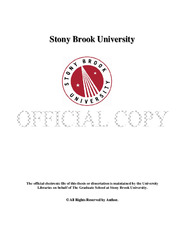| dc.identifier.uri | http://hdl.handle.net/11401/77563 | |
| dc.description.sponsorship | This work is sponsored by the Stony Brook University Graduate School in compliance with the requirements for completion of degree. | en_US |
| dc.format | Monograph | |
| dc.format.medium | Electronic Resource | en_US |
| dc.language.iso | en_US | |
| dc.publisher | The Graduate School, Stony Brook University: Stony Brook, NY. | |
| dc.type | Thesis | |
| dcterms.abstract | Beyond established associations between Milton’s Satan and the poet himself, I argue that Milton’s Satan, specifically in Book Nine of Paradise Lost, is a direct reflection of Milton, his career as a poet, and his precarious position in attempting to create a conclusion to his epic that does justice to the extraordinary narration of pre-fall history in Books I through IX. I will use a psychoanalytic approach in discussing what I believe to be Milton’s overwhelming desire to solidify his own position in the English literary canon, and the anxiety he seems to experience in a state of creative limbo. In this approach, I offer interpretations of the text that take a slightly different direction from prominent psychoanalytic criticisms by William Kerrigan and Michael Lieb; however, their arguments (especially Lieb’s) inform and enrich my own, as I attempt to extend his analysis of Milton’s anxieties related to the mutilation of his body to my own discussion of Milton’s creative anxieties. My analysis will also be supported with specific instances in both Milton’s prose and poetry where he reveals his poetic aspirations. I will begin with both literal and allegorical close readings of Satan’s soliloquy in Book IX, and other supporting pieces, including some of his earlier sonnets. The frame in which I examine Milton’s poetic career is the Virgilian career trajectory, and how Satan’s speech reveals Milton’s own poetic transition and achievements that follow the Virgilian rota (wheel). I address and offer alternatives to current, accepted theoretical discourse related to Milton’s treatment of Satan, specifically Milton self-identifying with Satan so closely, and the uneasy resolution he creates by ultimately distancing himself from Satan. Milton’s several instances (throughout Paradise Lost and earlier works) of self-representation, his struggles for identity and permanence, and his attempts at reconciling his secular art with spirituality complicate the notions that Milton wholeheartedly accepts God, and that Milton’s Satan is mostly an image of the poet in his earlier stages of development (as Kerrigan suggests). His decision to part ways with Satan seems more prompted by an obligation to follow the post fall story line presented in the scriptures, rather than an intentional denunciation of the self and submission to the divine. | |
| dcterms.abstract | Beyond established associations between Milton’s Satan and the poet himself, I argue that Milton’s Satan, specifically in Book Nine of Paradise Lost, is a direct reflection of Milton, his career as a poet, and his precarious position in attempting to create a conclusion to his epic that does justice to the extraordinary narration of pre-fall history in Books I through IX. I will use a psychoanalytic approach in discussing what I believe to be Milton’s overwhelming desire to solidify his own position in the English literary canon, and the anxiety he seems to experience in a state of creative limbo. In this approach, I offer interpretations of the text that take a slightly different direction from prominent psychoanalytic criticisms by William Kerrigan and Michael Lieb; however, their arguments (especially Lieb’s) inform and enrich my own, as I attempt to extend his analysis of Milton’s anxieties related to the mutilation of his body to my own discussion of Milton’s creative anxieties. My analysis will also be supported with specific instances in both Milton’s prose and poetry where he reveals his poetic aspirations. I will begin with both literal and allegorical close readings of Satan’s soliloquy in Book IX, and other supporting pieces, including some of his earlier sonnets. The frame in which I examine Milton’s poetic career is the Virgilian career trajectory, and how Satan’s speech reveals Milton’s own poetic transition and achievements that follow the Virgilian rota (wheel). I address and offer alternatives to current, accepted theoretical discourse related to Milton’s treatment of Satan, specifically Milton self-identifying with Satan so closely, and the uneasy resolution he creates by ultimately distancing himself from Satan. Milton’s several instances (throughout Paradise Lost and earlier works) of self-representation, his struggles for identity and permanence, and his attempts at reconciling his secular art with spirituality complicate the notions that Milton wholeheartedly accepts God, and that Milton’s Satan is mostly an image of the poet in his earlier stages of development (as Kerrigan suggests). His decision to part ways with Satan seems more prompted by an obligation to follow the post fall story line presented in the scriptures, rather than an intentional denunciation of the self and submission to the divine. | |
| dcterms.available | 2017-09-20T16:52:55Z | |
| dcterms.contributor | Pfeiffer, Douglas S | en_US |
| dcterms.contributor | Robinson, Benedict S | en_US |
| dcterms.creator | Johnson, David Thomas | |
| dcterms.dateAccepted | 2017-09-20T16:52:55Z | |
| dcterms.dateSubmitted | 2017-09-20T16:52:55Z | |
| dcterms.description | Department of English. | en_US |
| dcterms.extent | 42 pg. | en_US |
| dcterms.format | Monograph | |
| dcterms.format | Application/PDF | en_US |
| dcterms.identifier | http://hdl.handle.net/11401/77563 | |
| dcterms.issued | 2015-12-01 | |
| dcterms.language | en_US | |
| dcterms.provenance | Made available in DSpace on 2017-09-20T16:52:55Z (GMT). No. of bitstreams: 1
Johnson_grad.sunysb_0771M_12375.pdf: 677323 bytes, checksum: 16eabac4e872eed47bce87e26e375bdc (MD5)
Previous issue date: 1 | en |
| dcterms.publisher | The Graduate School, Stony Brook University: Stony Brook, NY. | |
| dcterms.subject | Literature | |
| dcterms.title | Milton's Satan as the Evolving Poet | |
| dcterms.type | Thesis | |

